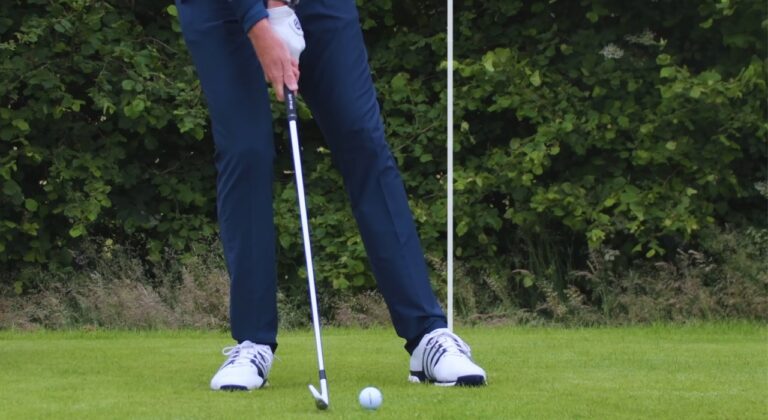As an ex amateur golfer, I’ve had my fair share of struggles with chipping and pitching. These skills can make or break your game, so let’s get straight to the point. I’m going to give you some advanced tips and insights to help you elevate your game to the next level. Let’s get started.
Club Selection
Choosing the right club is crucial for effective chipping and pitching. Let’s look at some important factors to consider when making your choice.
The Loft
Choosing the right loft can make a huge difference. When you’re near the green and need to go over an obstacle, consider a club with a higher loft. A 58- or 60-degree wedge is often a solid choice. Clubs with higher lofts tend to pop the ball up into the air more quickly.
This is ideal for clearing obstacles and stopping the ball closer to the pin. On the other hand, lower-lofted clubs like a 7- or 8-iron can be useful for chip shots where you want the ball to roll out more.
Bounce and Grind
Understanding bounce and grind can give you an edge. Clubs with more bounce are better suited for soft conditions or thicker grass, as they help prevent digging. A lower bounce is usually better for firm turf or tight lies because it allows the leading edge to slide under the ball more easily.
For grind, think about how the sole of the club interacts with the ground. Different grinds offer varying degrees of versatility, so pick one that matches the type of lies you frequently encounter.
Body Position and Alignment

Your body position and alignment are key to chipping and pitching success. Let’s dig into the specifics.
Stance and Posture
Getting your stance and posture right is essential. For chipping, use a narrow stance to ensure less movement in the lower body. Weight should be on the lead foot, promoting a downward strike.
Pitch shots require a slightly wider stance. Distribute your weight evenly between both feet. Maintain an upright posture to create room for your hands to swing through freely.
Ball Position
For chips, place the ball back in your stance near the trail foot. This helps create a descending blow, giving you more control. For pitch shots, position the ball more centrally in your stance.
This allows for a shallower angle of attack, helping you lift the ball more easily and get the height you need.
Mastering Spin Control
Spin control is an essential skill for chipping and pitching. Let’s explore how to get it right.
Mechanics of Spin
Generating backspin comes down to technique. Make sure to hit down and through the ball. The key is to strike the ball before the ground, brushing the turf lightly as you follow through.
To maximize spin, aim to hit the equator of the ball. This engages the grooves on the clubface, allowing for better friction and more spin.
Tools for Spin
Equipment matters in spin control. Choose a ball with a softer cover material like urethane. Also, make sure your wedges are in good condition. Worn-out grooves won’t grip the ball effectively, reducing your ability to impart spin.
Course Management
Strategic course management can also play a big role in improving your chipping and pitching.
Reading the Green
Learn how to read the green effectively. Look for the high and low points to understand how the ball will roll once it lands. Sometimes, a chip or pitch to the ‘fat’ part of the green is a better play than going directly at the pin.
Understanding Lies
Recognize how different types of lies affect your shots. From a fluffy lie, the ball tends to come out softer with less spin. From a tight lie, you get less margin for error but more spin. Adjust your technique accordingly.
Practice Drills
Practice makes perfect. Let’s look at some drills that can help you improve your chipping and pitching.
The Ladder Drill
Set up a series of targets at increasing distances from you. Try to land the ball as close to each target as possible. This helps improve your distance control.
The Box Drill
Create a box with tees around a hole on the putting green. Practice chipping into the box from various distances. This drill helps with both aim and distance control.
The Clock Face Drill
The clock face drill is excellent for mastering different swing lengths and understanding how far the ball will travel with each. Picture a clock face on the ground around you. Practice swinging back to various ‘hours’ on the clock and observe how far the ball travels.
This drill helps you build an intuitive sense of distance control. Knowing how far the ball will travel with different swing lengths allows you to adapt to various situations on the course.
The One-Handed Drill
It might sound unconventional, but practicing with one hand can enhance your feel for the club. Use just your lead hand (left hand for right-handed golfers, and vice versa) and try to chip or pitch the ball onto the green.
This drill promotes a better wrist hinge and teaches you to rely more on the bigger muscles, leading to a smoother swing. It’s particularly useful for developing softer hands, which can improve your touch around the greens.
Mindset and Strategy

Mental preparedness and strategic thinking also play crucial roles in chipping and pitching. Let’s explore these aspects.
Mental Preparation
Your mental state can heavily impact your short game. Negative thoughts or nerves can introduce tension into your swing, affecting your touch and feel. Positive self-talk and visualization techniques can be very effective in keeping you calm and focused.
Confidence in your abilities will make executing even the most challenging chip or pitch much more manageable. When you stand over the ball, trust your skill set and commit to the shot.
Game Strategy
Understand when to take risks and when to play it safe. Not every chip or pitch has to go directly at the flag. Sometimes, playing to a ‘safe zone’ on the green is the smarter choice, especially when the risk of a mistake is high.
Evaluating the risk-reward scenarios will help you make better decisions during the round. Always consider your lie, the pin position, and the green’s contour when planning your shot.
FAQs
How important is grip in chipping and pitching?
Grip plays a significant role in controlling the club and, subsequently, the ball. For chipping, a firmer grip can offer more control for shorter swings.
For pitching, a softer grip can provide better feel and touch. Customizing your grip pressure for these different shots can help you improve both distance and accuracy.
How does green speed affect my chipping and pitching?
Green speed, often measured by the Stimpmeter, impacts how far the ball will roll once it lands. Faster greens usually mean that the ball will roll out more, requiring you to land the ball closer to the front edge of the green.
Slower greens might require you to fly the ball closer to the hole, as it won’t roll out as much.
What role does tempo play in chipping and pitching?
Tempo is crucial for consistency. A rushed tempo can cause you to make contact with the ball inconsistently, leading to less control over distance and direction.
Maintaining a steady, rhythmic tempo ensures that your mechanics remain stable, making your chips and pitches more reliable.
Can I use my hybrid club for chipping around the green?
Yes, you can use a hybrid for chipping, especially when you’re just off the green and need the ball to roll a fair distance.
The hybrid’s design allows for a more forgiving contact and a ball trajectory that’s easier to control in terms of roll-out compared to a lower lofted iron.
How can I practice chipping and pitching if I don’t have access to a golf course?
You can practice your short game at home by using a chipping net or even just targeting specific areas in your yard. For pitching, focus on swings and follow through by using foam balls or even wiffle balls.
The key is to work on your technique and build muscle memory, even if you can’t replicate the exact conditions of a golf course.
How do wind conditions affect my chipping and pitching shots?
Wind can have a significant impact, especially on higher-lofted pitch shots. A headwind can make the ball balloon and land short, while a tailwind can make it difficult to stop the ball near the hole.
In windy conditions, you may need to adjust your club selection and the force of your swing to better control the ball’s flight and landing point.
Final Thoughts
Chipping and pitching are nuanced arts. There are many variables, from club selection to spin control, that you need to master. But with strategic practice and the right mindset, you can turn these skills into your strongest assets on the golf course.
Remember, the best short game is a smart game. Make intelligent choices, understand your environment, and, most of all, keep practicing. Good luck, and see you on the green!
Lilly Carrillo, a dedicated golf aficionado and skilled writer, lends her unique perspective and in-depth knowledge to the readers of FloridaEliteGolfTour.com. With a rich background in golf commentary and a knack for capturing the essence of the game, she delivers captivating content that resonates with golfers of all levels.















